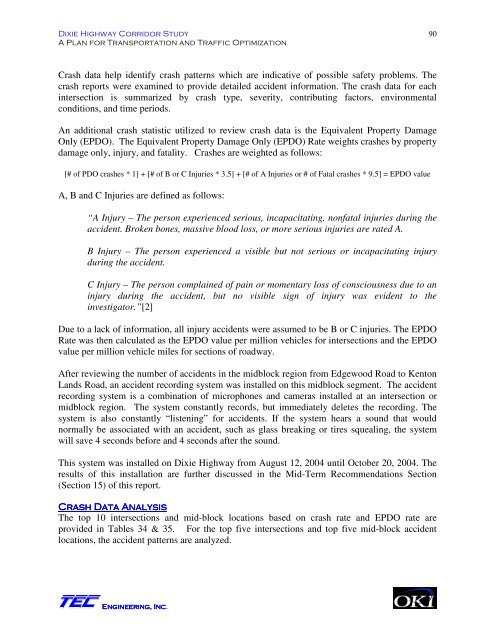11. Ac c iden t An al ysis Ac c iden t An al ysis - OKI
11. Ac c iden t An al ysis Ac c iden t An al ysis - OKI
11. Ac c iden t An al ysis Ac c iden t An al ysis - OKI
- No tags were found...
Create successful ePaper yourself
Turn your PDF publications into a flip-book with our unique Google optimized e-Paper software.
90Crash data help <strong>iden</strong>tify crash patterns which are indicative of possible safety problems. Thecrash reports were examined to provide detailed acc<strong>iden</strong>t information. The crash data for eachintersection is summarized by crash type, severity, contributing factors, environment<strong>al</strong>conditions, and time periods.<strong>An</strong> addition<strong>al</strong> crash statistic utilized to review crash data is the Equiv<strong>al</strong>ent Property DamageOnly (EPDO). The Equiv<strong>al</strong>ent Property Damage Only (EPDO) Rate weights crashes by propertydamage only, injury, and fat<strong>al</strong>ity. Crashes are weighted as follows:[# of PDO crashes * 1] + [# of B or C Injuries * 3.5] + [# of A Injuries or # of Fat<strong>al</strong> crashes * 9.5] = EPDO v<strong>al</strong>ueA, B and C Injuries are defined as follows:“ A Injury – The person experienced serious, incapacitating, nonfat<strong>al</strong> injuries during theacc<strong>iden</strong>t. Broken bones, massive blood loss, or more serious injuries are rated A.B Injury – The person experienced a visible but not serious or incapacitating injuryduring the acc<strong>iden</strong>t.C Injury – The person complained of pain or momentary loss of consciousness due to aninjury during the acc<strong>iden</strong>t, but no visible sign of injury was ev<strong>iden</strong>t to theinvestigator.” [2]Due to a lack of information, <strong>al</strong>l injury acc<strong>iden</strong>ts were assumed to be B or C injuries. The EPDORate was then c<strong>al</strong>culated as the EPDO v<strong>al</strong>ue per million vehicles for intersections and the EPDOv<strong>al</strong>ue per million vehicle miles for sections of roadway.After reviewing the number of acc<strong>iden</strong>ts in the midblock region from Edgewood Road to KentonLands Road, an acc<strong>iden</strong>t recording system was inst<strong>al</strong>led on this midblock segment. The acc<strong>iden</strong>trecording system is a combination of microphones and cameras inst<strong>al</strong>led at an intersection ormidblock region. The system constantly records, but immediately deletes the recording. Thesystem is <strong>al</strong>so constantly “ listening” for acc<strong>iden</strong>ts. If the system hears a sound that wouldnorm<strong>al</strong>ly be associated with an acc<strong>iden</strong>t, such as glass breaking or tires sque<strong>al</strong>ing, the systemwill save 4 seconds before and 4 seconds after the sound.This system was inst<strong>al</strong>led on Dixie Highway from August 12, 2004 until October 20, 2004. Theresults of this inst<strong>al</strong>lation are further discussed in the Mid-Term Recommendations Section(Section 15) of this report. The top 10 intersections and mid-block locations based on crash rate and EPDO rate areprovided in Tables 34 & 35. For the top five intersections and top five mid-block acc<strong>iden</strong>tlocations, the acc<strong>iden</strong>t patterns are an<strong>al</strong>yzed. !" .
















